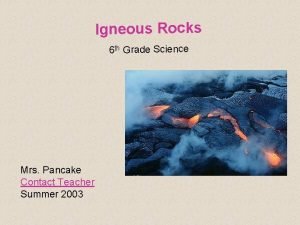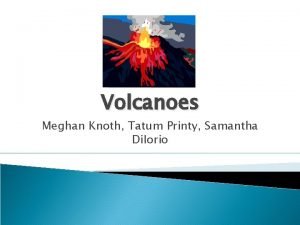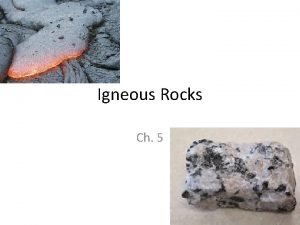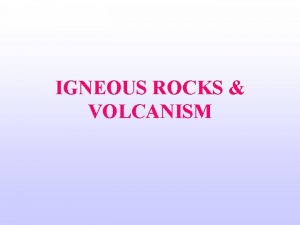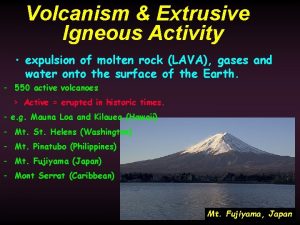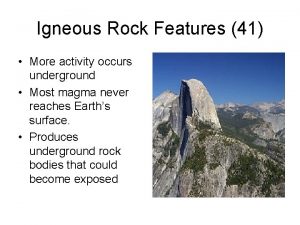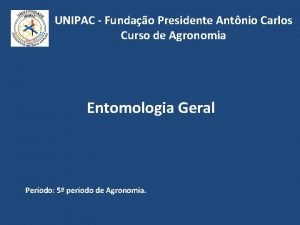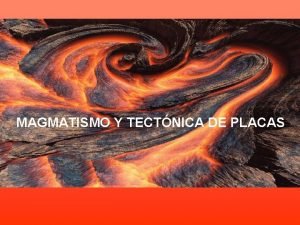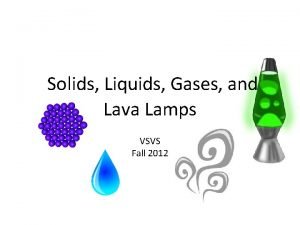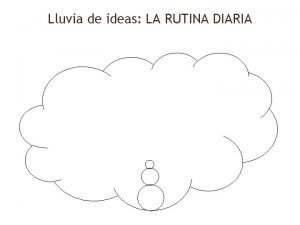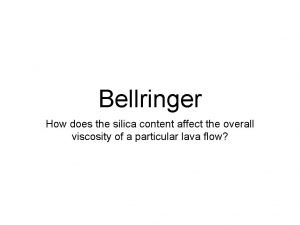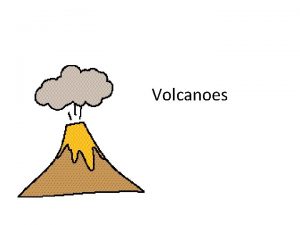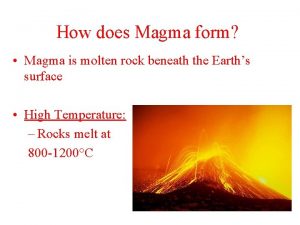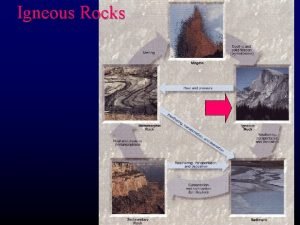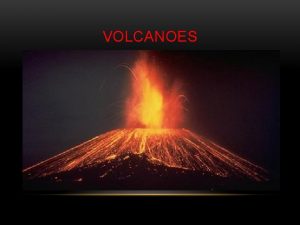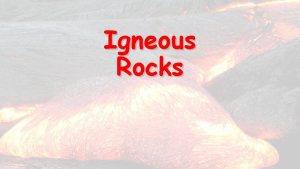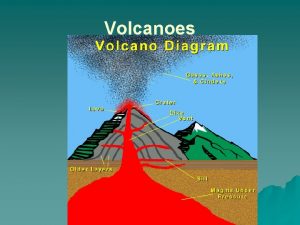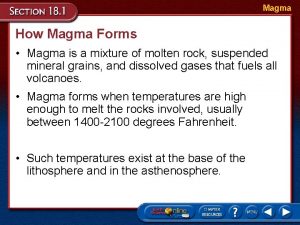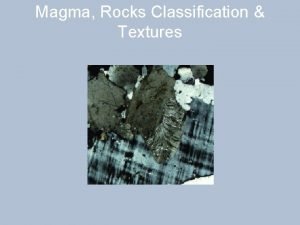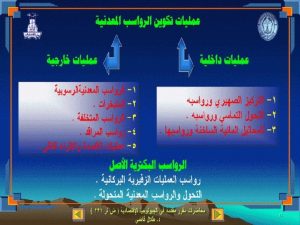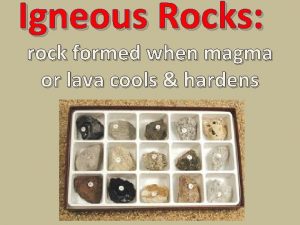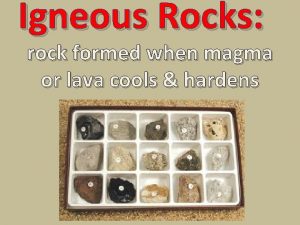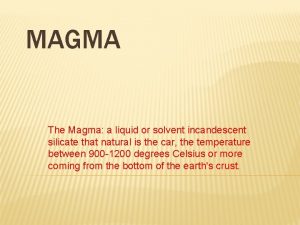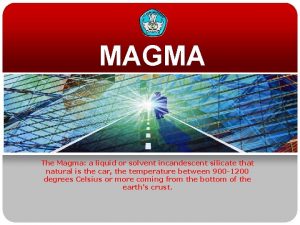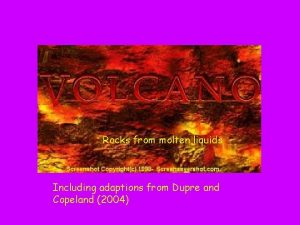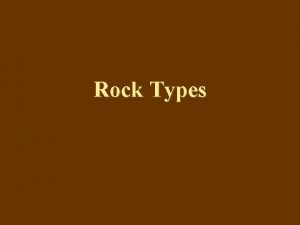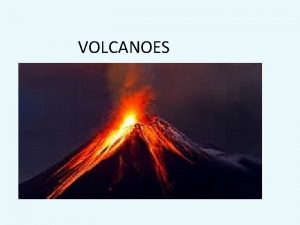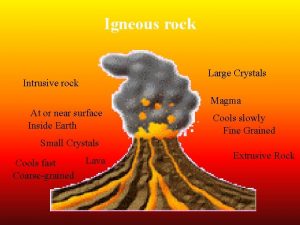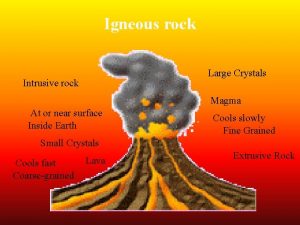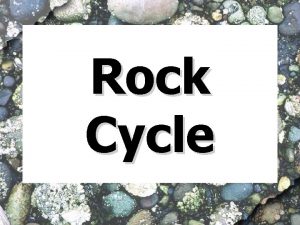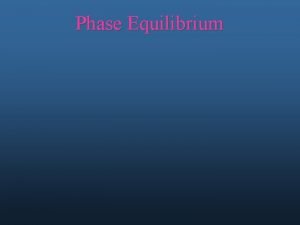Magma liquid molten rock underground Lava magma that




































- Slides: 36


Magma: liquid, molten rock underground Lava: magma that reaches the surface

The composition of lava depends on dissolved gases and silica content


Dissolved Gases Example: water vapor, carbon dioxide (CO 2), sulfur (S) *More gas = more explosive eruption

Silica Content More silica (Si. O 2) = thick magma Viscosity- ability to resist flow. High viscosity = thick flow Low viscosity = thin flow

Two classifications of lava: 1) Felsic: much silica, lightcolored, slow moving (continental crust)

2) Mafic: low silica and gas, dark-colored, fast moving (oceanic crust)

3 types of mafic lava: 1) Aa Lava= choppy 2) Pahoehoe = ropy

3) Pillow Lava= underwater

Hardened Lava In Hawaii

Volcano: place where magma reaches the surface Volcanism: when a fissure or crack develops in the crust allowing magma to reach the surface


Pahoehoe

HOT SPOTS: areas of volcanic activity in the middle of lithospheric plates

Hawaiian Islands

• Volcano Anatomy 1. Vent: opening from which lava flows 2. Crater: funnel-shaped pit or depression at top of volcano 3. Caldera: depression where the walls have collapsed


Volcanic vents turn into plugs when the lava cools

Diamond Head Crater in Hawaii

Pyroclastic Material (tephra): solid particles produced in eruptions 1. Ash (<2 mm) 2. Lapilli (<64 mm) 3. Bombs 4. Blocks

ash


lapilli

bombs

blocks

Types of volcanoes…

• composed of calm lava flows • form gently sloping, domeshaped mountain • basaltic (mafic) magma

Example: largest = Mauna Loa in Hawaii

• Made mostly of tephra and other rock particles • Formed from explosive eruptions • small, narrow base & steep sides • Grantic (felsic) magma


• Symmetrical build up of alternating layers of rock and lava • highly explosive eruptions with high silica and high gas content • forms large, cone-shaped mountains

Composite example 1 Mt. St. Helens- before

Mt. St. Helens- after

Ex. 2 -Mount Vesuvius - Pompeii 20 feet of volcanic ash smothered The city!

Mount Vesuvius – Pompeii= composite 20 feet of volcanic ash smothered The city!
 Perbedaan hot lava dan hot lava volcano
Perbedaan hot lava dan hot lava volcano Mrs pancake
Mrs pancake Shield volcanoes
Shield volcanoes Crystallize
Crystallize Igneous vs sedimentary or metamorphic
Igneous vs sedimentary or metamorphic Solidified lava rock family
Solidified lava rock family Expelled molten rock
Expelled molten rock Underground igneous rock bodies are called
Underground igneous rock bodies are called Tìm vết của đường thẳng
Tìm vết của đường thẳng Thể thơ truyền thống
Thể thơ truyền thống Tôn thất thuyết là ai
Tôn thất thuyết là ai Hãy nói thật ít để làm được nhiều
Hãy nói thật ít để làm được nhiều Thơ thất ngôn tứ tuyệt đường luật
Thơ thất ngôn tứ tuyệt đường luật Gây tê cơ vuông thắt lưng
Gây tê cơ vuông thắt lưng Ngoại tâm thu thất chùm đôi
Ngoại tâm thu thất chùm đôi Chiến lược kinh doanh quốc tế của walmart
Chiến lược kinh doanh quốc tế của walmart Sau thất bại ở hồ điển triệt
Sau thất bại ở hồ điển triệt Block nhĩ thất độ 3
Block nhĩ thất độ 3 Breakdown in liquid
Breakdown in liquid Lever arm rule liquid-liquid extraction
Lever arm rule liquid-liquid extraction Compaction and cementation
Compaction and cementation Explain the rock cycle
Explain the rock cycle Rock climbing rock climbing
Rock climbing rock climbing A rock climber's shoe loosens a rock and her climbing buddy
A rock climber's shoe loosens a rock and her climbing buddy Rock cycle
Rock cycle Chapter 3 standardized test practice answers
Chapter 3 standardized test practice answers Formigas lava pés
Formigas lava pés Factors affecting magma viscosity
Factors affecting magma viscosity What is a mountain
What is a mountain Femiche
Femiche Lava vacuolar
Lava vacuolar Lava lamp experiment explanation
Lava lamp experiment explanation La muchacha se lava ____.
La muchacha se lava ____. What is lava
What is lava Sebastiano lava
Sebastiano lava How does silica affect lava
How does silica affect lava Inter vs intramolecular
Inter vs intramolecular

